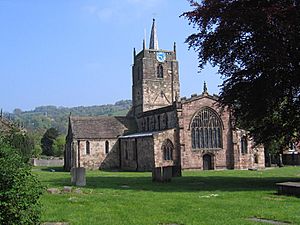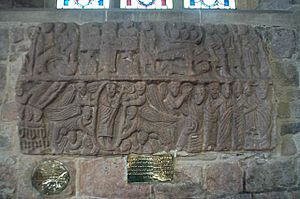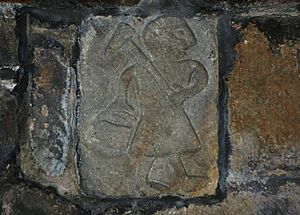St Mary's Church, Wirksworth facts for kids
Quick facts for kids St Mary's Church, Wirksworth |
|
|---|---|
 |
|
| 53°04′56″N 1°34′27″W / 53.08221°N 1.57404°W | |
| Country | United Kingdom |
| Denomination | Church of England |
| Churchmanship | Broad Church |
| Website | www.wirksworthteamministry.co.uk |
| History | |
| Dedication | St Mary the Virgin |
| Architecture | |
| Heritage designation | Grade I listed building |
| Designated | 24 October 1950 |
| Architectural type | Perpendicular Gothic |
| Specifications | |
| Length | 142ft |
| Width | 102ft |
| Administration | |
| Parish | Wirksworth |
| Diocese | Diocese of Derby |
| Province | Canterbury |
St Mary the Virgin is a historic church in Wirksworth, Derbyshire, England. It is a Church of England church, meaning it serves the local community. This building is very important, so it's listed as a Grade I listed building. Most of the church you see today was built between the 1200s and 1400s. However, parts of it are much older, dating back to the Anglo-Saxon period (before the year 1066). This shows that a church has stood on this spot since at least the 700s AD! The church was also fixed up in the 1800s, including work by a famous architect named Sir George Gilbert Scott.
Contents
Discovering the Church's History
St Mary's Church is famous for its amazing Anglo-Saxon carvings. These are ancient artworks made by people who lived in England a very long time ago. One of the most special finds was a large Anglo-Saxon coffin lid. It was found under the floor of the church in 1820. This lid is thought to be from the late 600s. Today, you can see it displayed on the north wall inside the church.
The Oldest Miner Carving
The church is also home to a unique Anglo-Saxon carving known as "T'owd Man." This carving shows a lead miner and is believed to be the oldest picture of a miner anywhere in the world! It was moved to St Mary's in 1863 from a nearby church in Bonsall to keep it safe. The people of Bonsall now have a copy of the carving in their church.
Other Ancient Carvings
Inside the church, you can find many other old carvings from the early medieval and medieval times. Many of these are small pieces from larger artworks. They have been carefully put together and displayed in the transept walls (the parts of the church that stick out like arms). These carvings include parts of old stone crosses, pieces of grave slabs, and figures like a wise man, a shepherd, and a bearded man's face.
Clipping the Church
St Mary's is one of the few churches in Britain that still practices an old tradition called clipping the church. This special event happens every year on the first Sunday after September 8th. On this day, people gather around the church and hold hands, forming a circle to "clip" or hug the church. It's a way to show their love and connection to the building and its history.
Recent Updates to the Church
In 2020, the roof of the nave (the main part of the church) was replaced. This was important because leaks were starting to damage the inside of the church. A special ceremony, called a "topping out" ceremony, was held with the Bishop of Derby on August 18, 2020, to celebrate the new roof. The church has also asked for a new poem to be written about its tower and bells.
Important Memorials
Inside St Mary's Church, you can find several memorials to important people from the past.
Gell Family Tombs
In the north aisle (a side section of the church), there are the tombs of the Gell family. One tomb has a statue of Sir Anthony Gell, who passed away in 1583. Next to it is the simpler tomb of his father, Sir Ralph Gell.
Sir Anthony Lowe's Tomb
The chancel (the area around the altar) holds the tomb of Sir Anthony Lowe. He was a special attendant to several kings and queens of England, including Henry VII, Henry VIII, Edward VI, and Mary I. He died in 1555.
Other Notable Burials
- Abraham Bennet: An inventor who created the gold-leaf electroscope and improved a device for measuring magnetism.
- Matthew Peat: His tomb is in the churchyard. He was from Alderwasley and is said to have lived to be 109 years and 10 months old when he died in 1751.
Church Community and Parishes
St Mary's Church is part of a larger group of churches that work together. This is called a "joint parish." It means they share resources and support each other. St Mary's is connected with several other churches in the area, including:
- All Saints' Church, Alderwasley
- St James the Apostle's Church, Bonsall
- All Saints' Church, Bradbourne
- All Saints' Church, Ballidon
- St James' Church, Brassington
- St Margaret's Church, Carsington
- All Saints' Church, Elton
- St James' Church, Idridgehay
- Holy Trinity Church, Kirk Ireton
- Holy Trinity Church, Middleton-by-Wirksworth
Church Leaders (Vicars and Rectors)
The church has had many leaders over the centuries. Here are some of the people who have served as vicars or rectors:
- 1270 Nicholas de Oxton
- 1349 Robert de Darbi
- 1520 Anthony Draycott
- 1667 Thomas Brown (who was also an Archdeacon)
- 1714 John Inett
- 1831 John Harward
- 1902 Hubert Arnold Gem
- 1951 Geoffrey Busby
- 2004 David C. Truby (Rector)
- 2023 Neil T. Griffiths (Rector)
The Church Organ
St Mary's Church has a long history with its organs, which are musical instruments that make sound using air through pipes.
Early Organs
In 1826, a two-manual organ (meaning it had two keyboards) was put in the church by Thomas Elliot. It cost £400, which was a lot of money back then! This organ was first placed in the church tower but was moved in 1853 to a better spot in the nave.
In 1899, a new, larger pipe organ was installed. It had three manuals and 26 "speaking stops," which are controls that change the sound of the organ. This organ was rebuilt in 1955 to use electric action.
Modern Organ
The pipe organ was replaced in 1987 with a modern electronic digital organ. This organ also has three manuals but can make 48 different sounds, offering a wide range of music.
Organists
The organists are the people who play the organ for church services and concerts. Here are some of the organists who have played at St Mary's:
- George Frederick Simms (until 1832)
- Thomas Reeves (1832–1860)
- Edward Birch (1860–1878)
- Carl Ashover (1899–1916)
- F. Isherwood-Plummer (1920–1922)
- Edward S. Jones (around 1923–1936)
- Christopher Dixon (1980–2023)
|
See also
- Grade I listed churches in Derbyshire
- Grade I listed buildings in Derbyshire
- Listed buildings in Wirksworth



